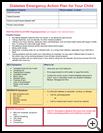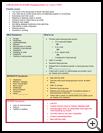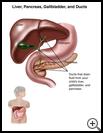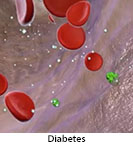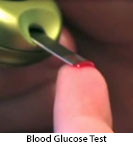
Diabetes: Type 2
___________________________________________________________________
KEY POINTS
- Type 2 diabetes means that there is too much sugar in your child’s blood. Your child’s body makes insulin but cannot use it well to get sugar from the blood into his cells.
- Too much sugar in your child’s blood can cause problems such as heart disease, stroke, blindness, and kidney failure.
- Your healthcare provider will help you learn to manage your child’s diabetes by testing his blood sugar, providing the right diet, helping him stay physically active, and helping him take his medicine as prescribed.
________________________________________________________________________
What is type 2 diabetes?
Having diabetes means that there is too much sugar (glucose) in your child’s blood. Your child’s body breaks down some of the foods your child eats into sugar. The blood carries the sugar to the cells of the body. Your child needs the sugar in the cells for energy, but too much sugar in the blood is not good for your child’s health.
What is the cause?
Diabetes is a problem with the way the body makes or uses insulin. Insulin is a hormone made by the pancreas, which is an organ in the upper belly. Your child’s body uses insulin to help move sugar from the blood into the cells. When the body does not have enough insulin or has trouble using its own insulin, sugar cannot get into the cells and builds up in your child’s blood. Diabetes can damage small blood vessels and nerves, causing problems in the eyes, heart, brain, kidneys, skin, and feet.
The exact cause of type 2 diabetes is not known. Your child has a higher risk of having type 2 diabetes if you have a family background of Alaska Native, American Indian, African American, Hispanic/Latino, Asian American, or Pacific Islander. The risk is also increased if your child has a family history of type 2 diabetes, doesn't get enough physical activity, has a high-calorie diet, or is overweight.
If you had gestational diabetes when you were pregnant, your child has a higher risk of type 2 diabetes.
This type of diabetes usually starts in adulthood. However, more teenagers and even children are developing type 2 diabetes.
What are the symptoms?
Symptoms may start suddenly or they may develop over days to weeks. Most people, however, have no symptoms for months or even years. This is why it is so important to get your blood sugar checked as often as your healthcare provider recommends.
Not everyone has the same symptoms. Symptoms may include:
- Urinating a lot
- Increased thirst
- Increased hunger
- Blurry vision
- Feeling tired all the time
- Unexpected weight gain or weight loss
- Dry, itchy skin
- Frequent infections—for example, of the skin, gums, or bladder
- Frequent yeast infections of the vagina
- Infections of the foreskin in uncircumcised males
- Thickened, darkened skin on the neck or in body folds, such as under the arms
If diabetes is not diagnosed and treated, your child’s blood sugar could get so high that it causes your child to go into a coma and die.
How is it diagnosed?
Your child’s healthcare provider will ask about your child’s symptoms and medical history and examine your child. Your child will have tests to measure the level of sugar in the blood. Tests may include:
- Fasting blood sugar test (FBS). For this test, your child’s blood sugar is tested in the morning after not eating any food or drinking anything except water at for least 8 hours.
- Hemoglobin A1C. The A1C is a blood test that can be used to check your child’s average blood sugar over the past 2 to 3 months.
- Glucose tolerance test (GTT). For this test, a sample of your child’s blood is taken when he has not eaten anything since the night before. Then your child drinks a special sugar drink and his blood is tested again 1 to 2 hours later. Your child’s blood sugar may be tested several more times after the first test, every 30 to 60 minutes.
- Random blood sugar test (RBS) at a time when your child has been eating normally.
Your child may have other blood tests to see what type of diabetes he has.
How is it treated?
The goal of treatment is to control the level of sugar in your child’s blood and keep it in a normal range. Controlling your child’s blood sugar can prevent or delay serious problems caused by diabetes.
When your child has type 2 diabetes, high blood sugar can often be controlled by eating healthy foods, getting regular exercise, and losing weight if your child is overweight. You need to check your child’s blood sugar regularly to make sure diet and exercise are working well. If diet and exercise are not controlling your child’s blood sugar, then he’ll need to take medicine to help keep sugar levels normal. It is also important to learn about diabetes, including recognizing and treating symptoms of high and low blood sugar.
- Diet
Your healthcare provider will give you guidelines about which foods your child should eat and how many calories to eat each day. Your child’s prescribed diet will include a lot of lean protein, complex carbohydrates (such as whole grain pastas breads, and cereals), fresh fruits and vegetables, and foods high in fiber. Your child may be able to have a snack with sugar sometimes, but your child’s regular diet should not include sugary food such as soft drinks, candy, and desserts. You will also learn how to space your child’s meals so he doesn’t go too long without food.
Your provider may refer you to a dietitian or diabetes educator for help with meal planning. Choosing healthy foods for your child’s diet may help him lose weight if he needs to, and improve his health. Sometimes losing just a few pounds can lower your child’s blood sugar enough to keep him from needing to take medicine to treat the diabetes.
- Exercise
Exercise is very important. Exercise improves blood flow, uses up more of the sugar in the blood, and helps your child’s body use insulin better. Getting enough physical activity is all some children need to control their blood sugar. A good activity plan can help control your child’s blood sugar level. It also helps keep him healthy and avoid some of the problems caused by diabetes. Talk to your healthcare provider about the right activity plan for your child.
- Medicine
If your child’s blood sugar can’t be controlled with diet and exercise, your healthcare provider may prescribe an oral medicine to lower it. Your child may also need more than 1 type of medicine to keep his blood sugar in a normal range. Your child may need shots of insulin if diet, exercise, and oral medicines are not keeping blood sugar levels normal. Your child can learn to give himself shots of insulin between the ages of 10 or 11 years.
When your child takes medicine for diabetes, you must carefully follow your provider's directions for checking your child’s blood sugar. This will help keep your child’s blood sugar from getting too high or too low. Blood sugar that is too low can make your child sick and cause headaches, nausea, cold sweats, and seizures. It can even be life-threatening if it gets too low.
- Blood sugar tests
You will learn how to check your child’s blood sugar with a small machine called a blood glucose meter. Your provider will tell you when and how often you need to check your child’s blood sugar. When your child is 7 to 10 years old, he can learn how to test his blood sugar himself.
You will need to keep a record of your child’s blood sugar measurements and bring it to every appointment. Your provider will check the record at appointments to see if any changes need to be made to your child’s medicine.
Your child may have an A1C test every 3 to 6 months to check overall control of his blood sugar. The A1C test is a way of measuring average sugar over a 3-month period. It’s a good way to see if your child’s diabetes is under control. However, it does not replace daily blood sugar measurements. Daily checks of your blood sugar show whether your child’s treatment is working throughout the day.
- Education
When your child is diagnosed with diabetes, there is a lot to learn about the disease. This education is usually done for 2 or 3 days at a diabetes clinic. This education is very important. Ask your healthcare provider about your choices.
Healthcare providers will teach you what diabetes is, and how to give shots of the proper amounts of insulin if needed. You will learn how to test for sugar in the blood and for ketones in the blood or urine. You will learn how to treat high and low blood sugar and other ways to keep your child healthy.
How can I take care of my child?
You can learn to take good care of your child in a few weeks and your child can keep doing most of his favorite activities. You need to work with your healthcare provider, change your child’s eating habits, add or continue physical activities, maintain a healthy weight, and check your child’s blood sugar on the schedule your provider recommends.
Carefully controlling blood sugar and taking care of any other health problems your child has may prevent or delay serious health problems. Good control of diabetes depends on following the diet and exercise plans prescribed by your healthcare provider to keep your child’s blood sugar in the target range. If your child’s diabetes is not controlled by diet and exercise, it is important for your child to take medicines as directed by your healthcare provider. Follow the full course of treatment prescribed by your healthcare provider. In addition:
- Try to always have your child’s meals, snacks, and exercise at the same time each day. Your child should carry a protein snack, such as cheese and crackers or peanuts, to make sure he eats as often as he should.
- Follow your healthcare provider's instructions for testing your child’s blood and adjusting his insulin dosage according to the results of the blood tests.
- Get your child’s eyes checked as often as your provider recommends.
- Make sure that your child stays physically active as advised by your child’s provider.
- Get other medical problems treated, especially high blood pressure and high cholesterol.
- Your child should carry a medical ID (such as a card or bracelet) that says he has diabetes.
- Learn about diabetes and its complications so you can make the correct decisions to control your child’s blood sugar levels. There is a lot to learn. It's good for everyone in your family to learn about diabetes.
- Following all of the steps to manage your child’s diabetes may feel overwhelming. If you or your child feel stressed or depressed, talk with a counselor.
Children with diabetes are faced with the same pressures as other kids. They may be curious about smoking, drinking alcohol, or using drugs. Smoking speeds up damage to the heart and blood vessels. Alcohol and drugs can affect blood sugar and can cause nerve damage over time. Talk to your child about the risks of smoking, drinking alcohol, and using drugs.
Ask your child’s provider:
- How and when you will get your child’s test results
- If there are activities your child should avoid and when your child can return to normal activities
- How to take care of your child at home
- What symptoms or problems you should watch for and what to do if your child has them
Make sure you know when your child should come back for a checkup. Keep all appointments for provider visits or tests. Be sure to take your child’s sugar logs or glucose meter to all appointments.
How can I help prevent type 2 diabetes?
Unlike type 1 diabetes, type 2 can be prevented. Even if there is a history of diabetes in your family, your child may be able to prevent the disease if he:
- Keeps a healthy weight.
- Stays physically active as advised by your child’s provider.
- Eats a healthy diet that includes fruits, vegetables, lean protein, and high-fiber grains. It’s best to limit sugars, soda, desserts, white rice, white potatoes, and foods made with white flour. Your child should choose whole grain and whole wheat breads and cereals instead.
If you have a family history of diabetes or your child is overweight, have his blood sugar checked as often as recommended by your healthcare provider.
You can get more information from:
- The American Diabetes Association
800-342-2383
http://www.diabetes.org
Last modified: 2018-01-23
Last reviewed: 2018-01-10

